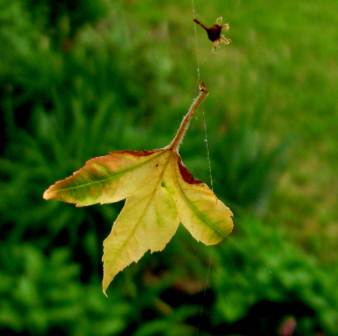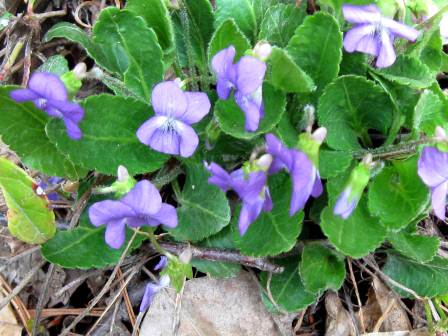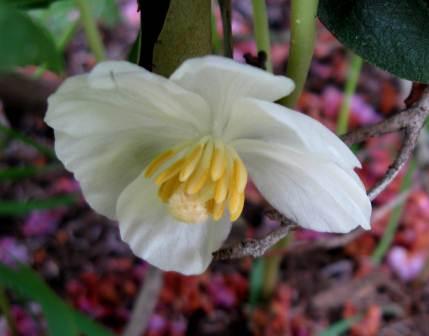I think I could post something like this every day and still not be able to show all of the flowers that are blooming right now. Most of the flowers appearing in this post are old friends that I’ve known for years.  White Clover (Trifolium repens) is blooming everywhere now and is very good for a lawn because it is a nitrogen fixing plant, meaning it converts atmospheric nitrogen into a soluble form that turf grasses and other plants can use. By doing this it acts as a free source of nitrogen. White clover also mows easily, stays quite short, and stays green throughout the season. It shouldn’t be used for high traffic areas though, because it can’t stand the abuse. I once gardened for some people whose lawn was about 90 percent white clover and it was beautiful.
White Clover (Trifolium repens) is blooming everywhere now and is very good for a lawn because it is a nitrogen fixing plant, meaning it converts atmospheric nitrogen into a soluble form that turf grasses and other plants can use. By doing this it acts as a free source of nitrogen. White clover also mows easily, stays quite short, and stays green throughout the season. It shouldn’t be used for high traffic areas though, because it can’t stand the abuse. I once gardened for some people whose lawn was about 90 percent white clover and it was beautiful.  Red clover (Trifolium pretense) on the other hand, although it fixes nitrogen like white clover, grows too fast and too tall for a lawn. It also forms large, tough clumps that are hard to mow. It’s an excellent feed crop, so keep red clover in pastures and meadows. This is Vermont’s state flower.
Red clover (Trifolium pretense) on the other hand, although it fixes nitrogen like white clover, grows too fast and too tall for a lawn. It also forms large, tough clumps that are hard to mow. It’s an excellent feed crop, so keep red clover in pastures and meadows. This is Vermont’s state flower.  Nothing says June like the Oxeye daisy (Leucanthemum vulgare.) The trouble is, it’s still May, so these are about 2 weeks early. Though we have come to think of this plant as a native, it was actually introduced from Europe or Asia. The Shasta daisy that is so well known in gardens was developed by plant breeder Luther Burbank from introduced species like this one.
Nothing says June like the Oxeye daisy (Leucanthemum vulgare.) The trouble is, it’s still May, so these are about 2 weeks early. Though we have come to think of this plant as a native, it was actually introduced from Europe or Asia. The Shasta daisy that is so well known in gardens was developed by plant breeder Luther Burbank from introduced species like this one.
 A close-up of an oxeye daisy.
A close-up of an oxeye daisy.  Dame’s rocket (Hesperis matronalis) is considered an invasive species and can be seen in fields and along roadsides in abundance. It was so highly valued that it was brought over from England by the colonists in the 1600s. This plant forms clumps much like phlox and can get 5 feet tall under the right conditions. The flowers range from purple to white and are very fragrant, especially in the evening. The easiest ways to tell that this plant isn’t phlox is by the narrower, slightly toothed leaves and the fact that phlox has 5 petals and dame’s rocket has 4. This plant is in the mustard family.
Dame’s rocket (Hesperis matronalis) is considered an invasive species and can be seen in fields and along roadsides in abundance. It was so highly valued that it was brought over from England by the colonists in the 1600s. This plant forms clumps much like phlox and can get 5 feet tall under the right conditions. The flowers range from purple to white and are very fragrant, especially in the evening. The easiest ways to tell that this plant isn’t phlox is by the narrower, slightly toothed leaves and the fact that phlox has 5 petals and dame’s rocket has 4. This plant is in the mustard family.  Bird’s foot trefoil (Lotus corniculatus) is a common plant seen on roadsides and parking lot edges, which is where I found this one. It is in the pea family and grows about a foot tall. It gets its common name from its clusters of brown, 1 inch long seed pods which someone thought looked like a bird’s foot. The plant has 3 leaflets much like clover. This plant was introduced from Europe as livestock feed but has escaped and is now considered invasive in many areas. It can form large mats that choke out natives.
Bird’s foot trefoil (Lotus corniculatus) is a common plant seen on roadsides and parking lot edges, which is where I found this one. It is in the pea family and grows about a foot tall. It gets its common name from its clusters of brown, 1 inch long seed pods which someone thought looked like a bird’s foot. The plant has 3 leaflets much like clover. This plant was introduced from Europe as livestock feed but has escaped and is now considered invasive in many areas. It can form large mats that choke out natives.  There are many different species of forget me nots (Myosotis.) Some are native and some were introduced and all have cross bred so there are many hybrids. There is a lot of confusion surrounding these plants, with some insisting they are native and some insisting they came from Europe. I try to stay out of all that and just enjoy their beautiful blue color.
There are many different species of forget me nots (Myosotis.) Some are native and some were introduced and all have cross bred so there are many hybrids. There is a lot of confusion surrounding these plants, with some insisting they are native and some insisting they came from Europe. I try to stay out of all that and just enjoy their beautiful blue color.  Bunchberry (Cornus canadensis) is blooming. I haven’t seen many of these this year, which is strange because they used to be very common. The Cornus part of the scientific name tells us that this plant is in the dogwood family, though just looking at it gives that away because it looks much like a dogwood blossom. Like a dogwood the flowers are the tiny greenish white clusters that make up the center disc. The large white “petals” are actually bracts. The common name “bunchberry” comes from its tight cluster of red berries.
Bunchberry (Cornus canadensis) is blooming. I haven’t seen many of these this year, which is strange because they used to be very common. The Cornus part of the scientific name tells us that this plant is in the dogwood family, though just looking at it gives that away because it looks much like a dogwood blossom. Like a dogwood the flowers are the tiny greenish white clusters that make up the center disc. The large white “petals” are actually bracts. The common name “bunchberry” comes from its tight cluster of red berries. After trying to photograph speedwell flowers that were one step above microscopic I found the germander speedwell (Veronica chamaedrys,) seemed gigantic in comparison because of its 3/16 to 1/4 inch flowers. It also called bird’s eye speedwell. This is another plant introduced from Europe and Asia. It has the strange habit of wilting almost as soon as it is picked, so it isn’t any good for floral arrangements. Like all the speedwells I’ve seen it has one lower petal smaller than the other three. Speedwell is very common in lawns.
After trying to photograph speedwell flowers that were one step above microscopic I found the germander speedwell (Veronica chamaedrys,) seemed gigantic in comparison because of its 3/16 to 1/4 inch flowers. It also called bird’s eye speedwell. This is another plant introduced from Europe and Asia. It has the strange habit of wilting almost as soon as it is picked, so it isn’t any good for floral arrangements. Like all the speedwells I’ve seen it has one lower petal smaller than the other three. Speedwell is very common in lawns.  I was lucky enough to stumble onto a colony of 50 or 60 painted trilliums (Trillium undulatum) that were spread out along a roadside. These blossoms were fresh-not like the ones that had just about gone by that I posted before. This is, in my opinion, one of our most beautiful wildflowers.
I was lucky enough to stumble onto a colony of 50 or 60 painted trilliums (Trillium undulatum) that were spread out along a roadside. These blossoms were fresh-not like the ones that had just about gone by that I posted before. This is, in my opinion, one of our most beautiful wildflowers.  This native plant fools a lot of people because it looks so much like Solomon’s seal (Polygonatum commutatum.) It is actually false Solomon’s seal (Maianthemum racemosum,) and the best way to tell that is by the flower cluster at the end of the stem. True Solomon’s seal flowers dangle under the leaves all along the stem. If the plant isn’t flowering you can still tell the difference by the stem itself; on false Solomon’s seal it zig zags like what is seen in the photo and on true Solomon’s seal it grows very straight.
This native plant fools a lot of people because it looks so much like Solomon’s seal (Polygonatum commutatum.) It is actually false Solomon’s seal (Maianthemum racemosum,) and the best way to tell that is by the flower cluster at the end of the stem. True Solomon’s seal flowers dangle under the leaves all along the stem. If the plant isn’t flowering you can still tell the difference by the stem itself; on false Solomon’s seal it zig zags like what is seen in the photo and on true Solomon’s seal it grows very straight.  Here is a photo of true Solomon’s seal (Polygonatum commutatum ) for comparison. Note the very different flowering habit between this plant and the false Solomon’s seal shown previously. There are about 50 species of true Solomon’s seal so identification can be tricky at times.
Here is a photo of true Solomon’s seal (Polygonatum commutatum ) for comparison. Note the very different flowering habit between this plant and the false Solomon’s seal shown previously. There are about 50 species of true Solomon’s seal so identification can be tricky at times. Yet another plant that mimics Solomon’s seal is Star Flowered Solomon’s Seal (Maianthemum stellatum,) so called because of the tiny star shaped blossoms that appear at the end of the stem. When compared to the true Solomon’s seal in the previous photo it is easy to see that the flowering habit is completely different. Again, the stem on this plant also zig zags, while the stem on true Solomon’s seal is straight.
Yet another plant that mimics Solomon’s seal is Star Flowered Solomon’s Seal (Maianthemum stellatum,) so called because of the tiny star shaped blossoms that appear at the end of the stem. When compared to the true Solomon’s seal in the previous photo it is easy to see that the flowering habit is completely different. Again, the stem on this plant also zig zags, while the stem on true Solomon’s seal is straight. I haven’t been able to identify the insect that was working so hard on this blue bead lily (Clintonia borealis) flower, but I think it was a false blister beetle, which is a pollen eater. This native plant is in the lily family. Its leaves resemble those of the lady’s slipper and it is sometimes mistaken for that plant or wild leeks. I found large colonies of it growing in a shady part of the forest where trillium and lady’s slippers grew. The yellowish green flowers will be followed by a shiny bright blue berry which is supposed to taste horrible.
I haven’t been able to identify the insect that was working so hard on this blue bead lily (Clintonia borealis) flower, but I think it was a false blister beetle, which is a pollen eater. This native plant is in the lily family. Its leaves resemble those of the lady’s slipper and it is sometimes mistaken for that plant or wild leeks. I found large colonies of it growing in a shady part of the forest where trillium and lady’s slippers grew. The yellowish green flowers will be followed by a shiny bright blue berry which is supposed to taste horrible. I’ve never seen a lupine (Lupinus) bloom in May but here they were, blooming happily on a river bank. This plant is in the pea family and like white and red clover fixes atmospheric nitrogen into a soluble form that can be used by plants. It is said that the lupine has been cultivated for 2000 years or more, beginning in ancient Egypt, because the seed is so high in protein. These are beautiful plants to have in the garden but are very susceptible to aphid attack.
I’ve never seen a lupine (Lupinus) bloom in May but here they were, blooming happily on a river bank. This plant is in the pea family and like white and red clover fixes atmospheric nitrogen into a soluble form that can be used by plants. It is said that the lupine has been cultivated for 2000 years or more, beginning in ancient Egypt, because the seed is so high in protein. These are beautiful plants to have in the garden but are very susceptible to aphid attack.  Sweet Viburnum (Viburnum lentago) is also known as nannyberry. These native bushes are dotting the woods with their white, mounded flower clusters right now. Red twig dogwoods are also beginning to bloom, but they have four petals and the viburnum have five. Dogwood flower clusters also tend to be much flatter on top and seem to hover just above the branch. Sweet viburnum has a much more rounded flowering habit. These shrubs are also called wild raisin and nanny plum for their fruit, which is a small black drupe with one flat seed.
Sweet Viburnum (Viburnum lentago) is also known as nannyberry. These native bushes are dotting the woods with their white, mounded flower clusters right now. Red twig dogwoods are also beginning to bloom, but they have four petals and the viburnum have five. Dogwood flower clusters also tend to be much flatter on top and seem to hover just above the branch. Sweet viburnum has a much more rounded flowering habit. These shrubs are also called wild raisin and nanny plum for their fruit, which is a small black drupe with one flat seed.  Northern Blue Flag Iris (Iris versicolor) has suddenly popped up around the local pond. These native plants love water and near water is where I always find them. There is also a southern blue flag (Iris virginica.) The “flag” part of the name comes from the Middle English flagge, which means rush or reed. The roots of this plant are extremely toxic, so if you forage for cattail roots be sure the roots of blue flag aren’t mixed in with them.
Northern Blue Flag Iris (Iris versicolor) has suddenly popped up around the local pond. These native plants love water and near water is where I always find them. There is also a southern blue flag (Iris virginica.) The “flag” part of the name comes from the Middle English flagge, which means rush or reed. The roots of this plant are extremely toxic, so if you forage for cattail roots be sure the roots of blue flag aren’t mixed in with them.
Suddenly I realize
That if I stepped out of my body I would break
Into blossom.~James Wright
I hope you enjoyed this one. Thank you for stopping by.



















































































 Eastern Redbud (Cercis Canadensis) is not native to New Hampshire and I have only seen two of the trees growing in this area. Both are on private property but this one had branches overhanging a sidewalk so I was able to get close to it. The hardiness of this tree can be questionable here unless trees started from northern grown seed are planted.
Eastern Redbud (Cercis Canadensis) is not native to New Hampshire and I have only seen two of the trees growing in this area. Both are on private property but this one had branches overhanging a sidewalk so I was able to get close to it. The hardiness of this tree can be questionable here unless trees started from northern grown seed are planted. 





























